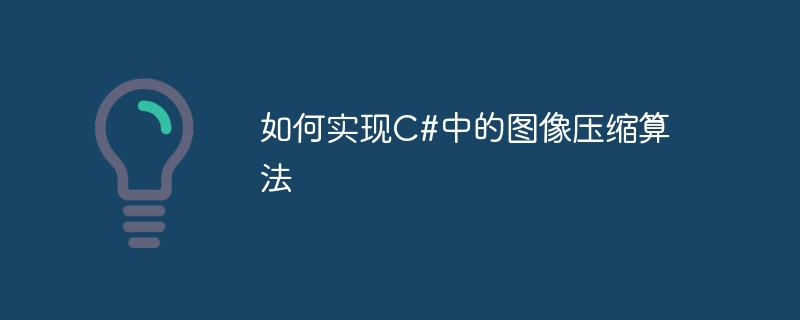如何实现C#中的图像压缩算法

如何实现C#中的图像压缩算法
摘要:图像压缩是图像处理领域中的一个重要研究方向,本文将介绍在C#中实现图像压缩的算法,并给出相应的代码示例。
引言:
随着数字图像的广泛应用,图像压缩成为了图像处理中的重要环节。压缩能够减小存储空间和传输带宽,并能提高图像处理的效率。在C#语言中,我们可以通过使用各种图像压缩算法来实现对图像的压缩。本文将介绍两种常见的图像压缩算法:Run-Length Encoding (RLE)和Lempel-Ziv-Welch (LZW),并给出相应的C#代码示例。
- Run-Length Encoding (RLE)算法
Run-Length Encoding (RLE)算法是一种简单而有效的图像压缩算法,它的原理是将连续重复的颜色值序列表示为一个计数值和相应的颜色值。下面是一个实现RLE算法的C#代码示例:
public byte[] RleCompress(byte[] image)
{
List<byte> compressedImage = new List<byte>();
int count = 1;
byte current = image[0];
for (int i = 1; i < image.Length; i++)
{
if (image[i] == current)
{
count++;
}
else
{
compressedImage.Add((byte)count);
compressedImage.Add(current);
count = 1;
current = image[i];
}
}
compressedImage.Add((byte)count);
compressedImage.Add(current);
return compressedImage.ToArray();
}
public byte[] RleDecompress(byte[] compressedImage)
{
List<byte> decompressedImage = new List<byte>();
for (int i = 0; i < compressedImage.Length; i += 2)
{
byte count = compressedImage[i];
byte color = compressedImage[i + 1];
for (int j = 0; j < count; j++)
{
decompressedImage.Add(color);
}
}
return decompressedImage.ToArray();
}- Lempel-Ziv-Welch (LZW)算法
Lempel-Ziv-Welch (LZW)算法是一种常用的无损压缩算法,它利用字典来存储已出现的字符串,将重复出现的字符串替换为相应的索引值。下面是一个实现LZW算法的C#代码示例:
public byte[] LzwCompress(byte[] image)
{
Dictionary<string, int> dictionary = new Dictionary<string, int>();
List<int> compressedImage = new List<int>();
string current = image[0].ToString();
for (int i = 1; i < image.Length; i++)
{
string next = current + image[i];
if (dictionary.ContainsKey(next))
{
current = next;
}
else
{
compressedImage.Add(dictionary[current]);
dictionary.Add(next, dictionary.Count + 1);
current = image[i].ToString();
}
}
compressedImage.Add(dictionary[current]);
byte[] compressedBytes = new byte[compressedImage.Count * 2];
for (int i = 0; i < compressedImage.Count; i++)
{
compressedBytes[i * 2] = (byte)(compressedImage[i] >> 8);
compressedBytes[i * 2 + 1] = (byte)(compressedImage[i] & 0xff);
}
return compressedBytes;
}
public byte[] LzwDecompress(byte[] compressedImage)
{
Dictionary<int, string> dictionary = new Dictionary<int, string>();
List<byte> decompressedImage = new List<byte>();
int nextCode = 256;
for (int i = 0; i < nextCode; i++)
{
dictionary.Add(i, ((char)i).ToString());
}
int current = (compressedImage[0] << 8) + compressedImage[1];
decompressedImage.AddRange(Encoding.Default.GetBytes(dictionary[current]));
for (int i = 2; i < compressedImage.Length; i += 2)
{
int code = (compressedImage[i] << 8) + compressedImage[i + 1];
if (!dictionary.ContainsKey(code))
{
string entry = dictionary[current] + dictionary[current][0];
dictionary.Add(code, entry);
decompressedImage.AddRange(Encoding.Default.GetBytes(entry));
}
else
{
decompressedImage.AddRange(Encoding.Default.GetBytes(dictionary[code]));
}
current = code;
}
return decompressedImage.ToArray();
}结论:
本文介绍了在C#中实现图像压缩的两种算法:Run-Length Encoding (RLE)和Lempel-Ziv-Welch (LZW)。通过实现相应的压缩和解压缩函数,我们可以对图像进行压缩和解压缩操作。这些算法是图像处理中常用的压缩算法,可以帮助我们减小存储空间和传输带宽,并提高图像处理的效率。
参考文献:
- Run-Length Encoding. Wikipedia. (https://en.wikipedia.org/wiki/Run-length_encoding)
- Lempel-Ziv-Welch. Wikipedia. (https://en.wikipedia.org/wiki/Lempel-Ziv-Welch)
以上是如何实现C#中的图像压缩算法的详细内容。更多信息请关注PHP中文网其他相关文章!

热AI工具

Undresser.AI Undress
人工智能驱动的应用程序,用于创建逼真的裸体照片

AI Clothes Remover
用于从照片中去除衣服的在线人工智能工具。

Undress AI Tool
免费脱衣服图片

Clothoff.io
AI脱衣机

Video Face Swap
使用我们完全免费的人工智能换脸工具轻松在任何视频中换脸!

热门文章

热工具

记事本++7.3.1
好用且免费的代码编辑器

SublimeText3汉化版
中文版,非常好用

禅工作室 13.0.1
功能强大的PHP集成开发环境

Dreamweaver CS6
视觉化网页开发工具

SublimeText3 Mac版
神级代码编辑软件(SublimeText3)
 使用 C# 的活动目录
Sep 03, 2024 pm 03:33 PM
使用 C# 的活动目录
Sep 03, 2024 pm 03:33 PM
使用 C# 的 Active Directory 指南。在这里,我们讨论 Active Directory 在 C# 中的介绍和工作原理以及语法和示例。
 c#多线程和异步的区别
Apr 03, 2025 pm 02:57 PM
c#多线程和异步的区别
Apr 03, 2025 pm 02:57 PM
多线程和异步的区别在于,多线程同时执行多个线程,而异步在不阻塞当前线程的情况下执行操作。多线程用于计算密集型任务,而异步用于用户交互操作。多线程的优势是提高计算性能,异步的优势是不阻塞 UI 线程。选择多线程还是异步取决于任务性质:计算密集型任务使用多线程,与外部资源交互且需要保持 UI 响应的任务使用异步。












